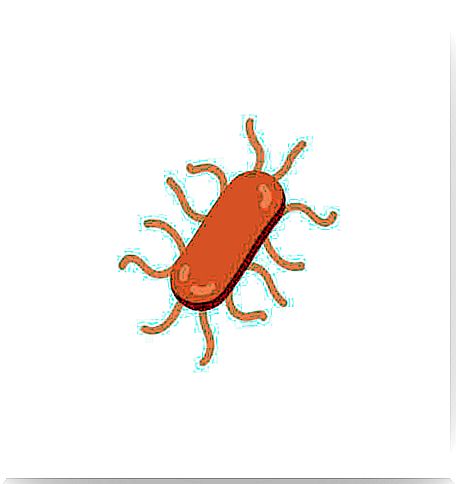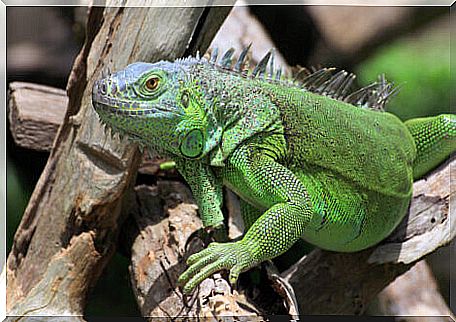Can Reptiles Or Amphibians Transmit Salmonellosis To Humans?

Salmonellosis is an infection transmitted by bacteria of the genus Salmonella. Some of these naturally live on reptiles and amphibians. When handling any exotic species, especially wild ones, a few extra precautions must be used.
The same animal can host several Salmonella strains in its organism . Fortunately, this genus is susceptible to most disinfectants as well as heat. By taking the necessary precautions in touching reptiles and amphibians, therefore, it is still possible to avoid contagion. Let’s find out more about the risks of catching salmonellosis from exotic reptiles or amphibians.
Can exotic reptiles and amphibians transmit salmonellosis?
The Salmonella is located within the gut of infected reptiles – even when no symptoms – and is transmitted primarily via the fecal-oral route, already that the potentially pathogenic microorganisms are expelled in a continuous manner or intermittent through the infected animal’s faeces .
A reptile or amphibian can contract Salmonella through the feces of another reptile or through contaminated food, water and other elements. On the other hand, the Salmonella comes to humans through direct contact with the reptile or amphibian, or through an object contaminated with feces, water or infected food.
This type of bacterium can survive for long periods in the environment, especially in hot and humid climates, as are usually the terrariums of reptiles and amphibians. It can remain there even after the animal no longer lives there. The bacterial load can remain for a period even on the tools used for cleaning or feeding.

Salmonellosis in humans
Once you have been infected with Salmonella, the first symptoms can appear between 6 and 76 hours after contact. These can last anywhere from 24 hours to 12 days. The main symptom of salmonellosis is gastroenteritis, which can present with varying degrees of severity. The infection can also be asymptomatic.
With typical salmonellosis gastroenteritis, other associated symptoms will appear. Eg:
- Nausea and vomit.
- Abdominal pain.
- Diarrhea.
- Headache.
- Fever and chills.
- Myalgia (muscle pain).
In many cases the symptoms disappear spontaneously after 1-7 days, but the infection can be more severe in very young, elderly or immunosuppressed people. However, it rarely becomes fatal.
Treatment for reptile- or amphibian-borne salmonellosis involves taking different types of antibiotics, depending on how resistant the bacterial strain is. If you own a reptile or an amphibian and you begin to experience the symptoms described above, go to the doctor as soon as possible giving him precise information about your animal. He will know how to find the correct diagnosis and treatment.
How to prevent salmonellosis
There is no vaccine to prevent the disease, but there are a number of recommendations to follow to avoid contracting the bacterium through your pet amphibian or reptile. Here is a list with the most important tips to stay safe without having to give up your pet:
- Wash your hands with soap and water – and frequently – after touching the reptile or its cage.
- Change your clothes after having had contact with these animals, especially if you will have encounters with small children – particularly prone to complications -, with the elderly or with immunosuppressed people.
- Avoid eating, drinking or smoking while holding the reptile or its enclosures.
- Do not allow reptiles to move freely around the house.
- Keep the terrarium away from the kitchen and other areas where food is being prepared.
- Do not use the kitchen sink to wash reptiles or clean their dishes, terrariums or accessories. If you use it for this purpose, be sure to disinfect it carefully immediately afterwards.
- As obvious as it sounds, don’t kiss your reptile or amphibian and don’t share food with him.
Can salmonellosis be caught from exotic reptiles or amphibians?
As a precaution, it is always good to assume that the reptiles and amphibians we have in the house can carry Salmonella, which is why it is recommended to follow the recommendations set out above. There are documented cases of the bacterium’s presence in turtles, lizards, iguanas, snakes, chameleons, frogs, salamanders and other amphibians.
However, the disease in these animals is relatively rare, with symptoms only visible if the animal is under stress or already ill. Furthermore, the incubation period is highly variable.
There are specific tests to detect Salmonella in these animals; consult an exotic species veterinarian if you want to remove any doubts. In reptiles, treatment with antibiotics is highly discouraged, which could worsen the clinical picture of the sick animal.

In most cases the bacterium present in the animal cannot be eliminated, therefore it is only possible to prevent the appearance of clinical pathologies and avoid the transmission of the bacterium to humans. Good hygiene and minimization of stress in the animal are key factors in ensuring their good health.









